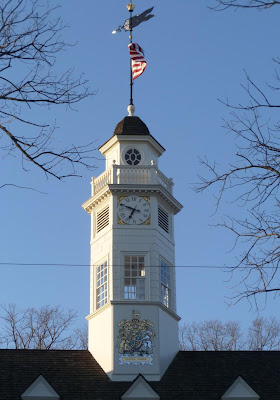Our fifth day in the historic city started hot and sunny, so we found ourselves seeking shade whenever possible, which was not easy because many of the trees had not yet sprouted leaves.
By day five the Palace garden was noticeably more colorful than it was five days earlier although you may have to enlarge this image to appreciate the colorful blooms.
We found the cook in the Palace kitchen busy cutting butter into flour to make breads of various shapes. The completed dishes in front of him included a couple puddings, a stuffed cabbage, veal kidney, salat with egg and several other dishes of which I can't remember their identity.
Although you can't see their faces well, one can appreciate our ladies' gowns on this stroll along Prince George Street.
We sought refuge from the afternoon heat listening to Ron Carnegie portray George Washington at the Kimball Theatre. I don't recall hearing Mr. Carnegie in a question-and-answer format before, but this presentation was consistent with the Washington speeches we've heard him deliver during Revolutionary City events. He portrays an unanimated President Washington, which may be accurate compared to Patrick Henry or even Thomas Jefferson, but when it comes across as condescending it quickly grows tiresome. Not a favorite, but I'll probably give him another chance in the future.
Our tour of the Everard house found few changes from our last visit, but that doesn't prevent me from sharing a couple photos and a bit of information. I've shown these dishes in a previous post but they were on a table and hard to see. As mentioned before, these dishes were recovered from a shipwreck after they had spent over 230 years at the bottom of the South China Sea. A representative of Colonial Williamsburg recognized the pattern when they came up for auction in China several decades ago, and spent quite a bit of money to obtain many of the pieces shown here. The pattern is identical to that found on dish fragments discovered in excavations around town, so the curators here are confident this pattern of dishware was used in this town in the colonial period. I'm told China is much more restrictive in what they allow to leave the country now, so that providential auction may have been the opportunity of a lifetime.
The Everard House kitchen stands to the left and the smokehouse to the right in this photo. Both structures are original and restored buildings that stood on the property in the mid 18th century.
Moving on to the Governor's Palace, the color of the paneling on the south wall of this comfortable little study caught Karen's eye. She's been thinking about a different blue for our kitchen at home, and although this color may not make the final cut, we think it's pretty nonetheless.
Dinner before our concert in the evening was at Christiana Campbell's Tavern. Since they specialize in seafood, most of us tried dishes based on local and non-local catches. We found each selection enjoyable, and would recommend this restaurant.
On our walk across town to the Governor's Palace for the concert I couldn't resist this shot of the cupola and flag above the Capitol Building in the fading evening light.







































